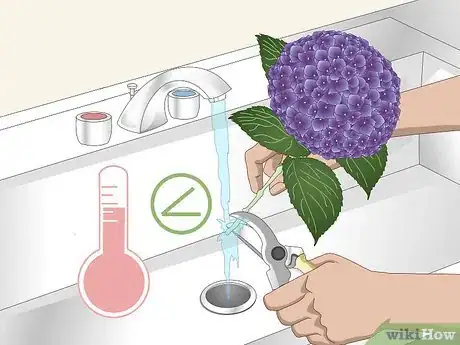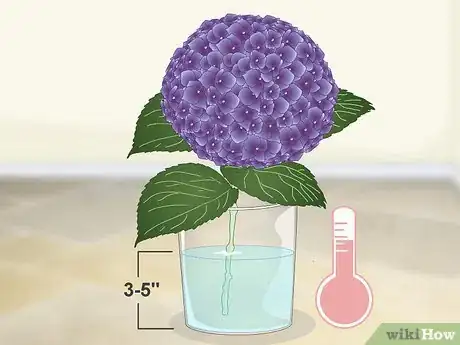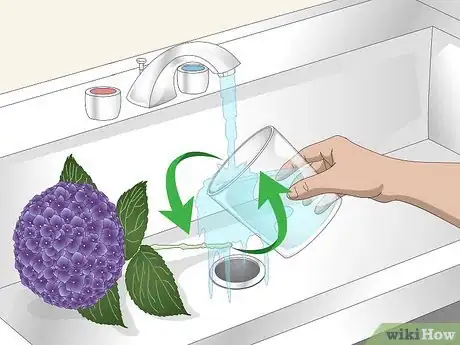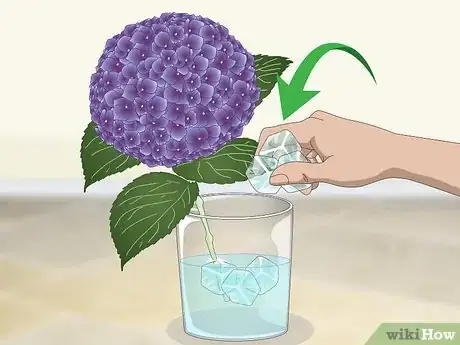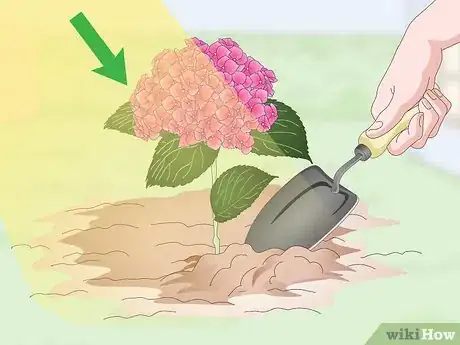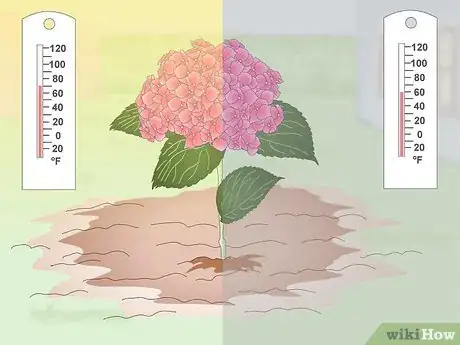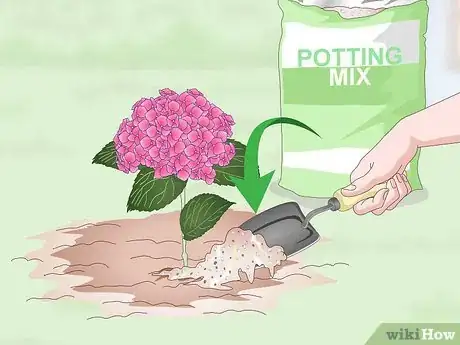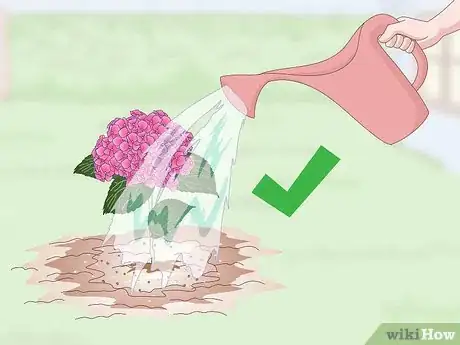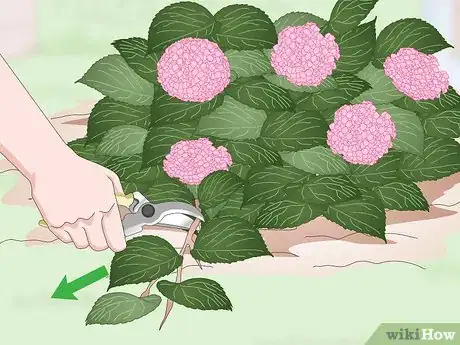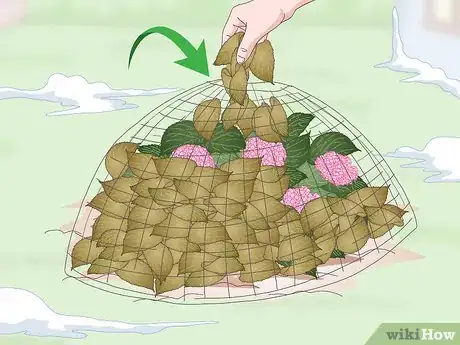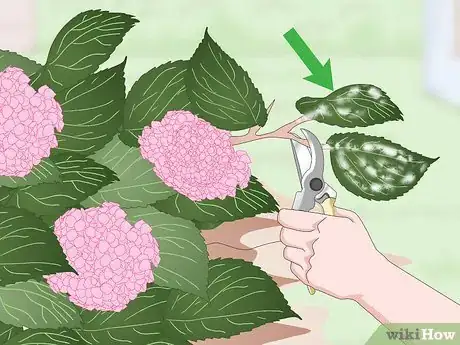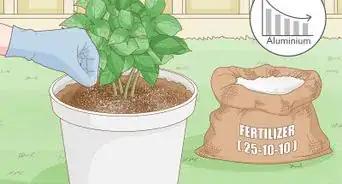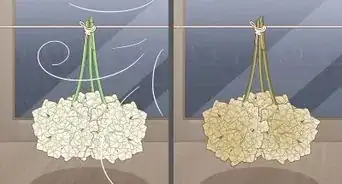This article was co-authored by Lauren Kurtz. Lauren Kurtz is a Naturalist and Horticultural Specialist. Lauren has worked for Aurora, Colorado managing the Water-Wise Garden at Aurora Municipal Center for the Water Conservation Department. She earned a BA in Environmental and Sustainability Studies from Western Michigan University in 2014.
There are 10 references cited in this article, which can be found at the bottom of the page.
This article has been viewed 70,375 times.
Hydrangeas are beautiful flowering plants that come in a variety of colors and sizes. If you want to keep your outdoor hydrangea plants looking nice, be sure to water them and prune them regularly. For cut hydrangea stems, try dipping the tips in alum spice powder, changing the vase water regularly, and dunking the hydrangea blooms in lukewarm water.
Steps
Making Cut Hydrangeas Live Longer
-
1Cut the stems at an angle. Give your hydrangea stems a deep diagonal cut across the bottoms. A diagonal cut will help minimize damage to the stem ends.
- Cutting the stems under warm running water will help prevent potentially damaging air bubbles from forming on the stem.
-
2Dip the hydrangea stems in alum spice powder after cutting the stems. Place a bit of alum powder on a plate, about 1⁄2 in (1.3 cm) deep. Once your hydrangea stems are cut, dip each individual stem in the alum powder. Then place the stem in a vase with water and arrange the flowers. This will help the blooms thrive for a longer period of time.[1]
- You should be able to find alum in the spice section of any grocery store.
Advertisement -
3Place the cut stems in lukewarm water immediately after cutting. Once you’ve cut the stems, you’ll need to get your hydrangea in water as quickly as you can. Fill a clean vase up with 3 in (7.6 cm) to 5 in (13 cm) of lukewarm or room temperature water.[2]
- Do not crush the stem ends, as this can prevent your hydrangea from hydrating.
-
4Mist the petals with water once a day. Hydrangeas actually absorb more water from their petals than through their roots and stems. If you have cut hydrangeas that you want to keep looking nice, you’ll need to gently mist the petals with water each day to keep them hydrated.[3]
- Use a spray bottle with a gentle misting stream so as not to damage the delicate petals.
-
5Replace the vase water every day. Fresh water will help your hydrangea blooms stay properly hydrated, and prevent them from wilting as quickly. Remove your cut hydrangeas from the vase and discard the old water. Refill the vase with fresh room-temperature water.[4]
- Rinse out the vase to remove any debris before adding the fresh water.
-
6Add ice to the vase if your hydrangeas wilt when exposed to high temperatures. For hydrangeas that have begun to wilt, fill the vase with 2 parts ice and 1 part water. This will help cool the plants down if they are overheated.[5]
- You should start to see improvements after one day. Feel free to continue the ice/water treatment for several days in an attempt to revive your hydrangeas.
-
7Dunk the flower heads in warm water if they start to wilt. If your hydrangea blooms begin wilting, you can give them a bit of life support by submerging them in a bowl of warm water for up to 30 minutes.[6]
- Be careful when lifting the hydrangea back up, as the water can make them quite heavy.
Caring for Planted Hydrangeas
-
1Plant your hydrangeas with sun exposure and protection from the wind. Hydrangeas need direct sunlight to thrive, so plant them in a spot that has either full or partial sun exposure. Your hydrangea should also be planted away from the wind.[7]
- Winds can actively dry your hydrangea plants even further, so be sure to protect your plant from the wind and hydrate it frequently.
-
2Plant hydrangeas in moderate climates. Hydrangeas thrive in U.S. Department of Agriculture plant hardiness zones 3-9. The ideal temperature is around 70 °F (21 °C) during the daytime and just under 60 °F (16 °C) at night. If it is hotter than this, the blooms might wilt. And in colder temperatures, the foliage may suffer from frost.[8]
- In the fall, hydrangeas are making buds that will bloom the following year. During this time, hydrangeas need a 6-week period of temperatures below 65 °F (18 °C) for the buds to set.
-
3Use standard potting soil or compost to plant your hydrangeas. If you plant your hydrangeas in the ground (instead of in a pot), make sure to add some potting soil or bagged compost to the potting hole to help the plant handle the transition. But remember that the color of the hydrangea flowers is determined by the soil’s pH level.[9]
- A high number of aluminum ions in the soil will produce blue hydrangea blooms.
- A pH level of 6.0 and above will produce pink hydrangea blooms.
- White hydrangea blooms are not affected by the pH level of the soil.
-
4Water the hydrangeas each day so that the soil remains moist. Hydrangeas need to stay hydrated to survive, especially during the first couple of years. If the soil is too dry, the leaves and petals will start wilting. Try watering your hydrangea plants each day – just enough water to keep the soil moist – and see how they do. At a minimum, water your hydrangea plant at least 3 times per week.[10]
- You may want to water less if you live in a particularly rainy climate, or more if you live in a very dry climate.
- If the leaves start wilting, try watering more. If the plant starts looking sticky or wet, consider watering it less frequently.
-
5Keep your hydrangea plant pruned. While it may seem counterproductive to cut off some of the plant to improve health and growth, this is actually a very common practice. Prune away any older stems or shoots that seem to be wilting or fading.[11]
- Always cut above a node on the stem.
- Removing old growth will make room for new growth!
-
6Cover the plant with leaves or mulch in the fall to protect it from frost. If you want your hydrangeas to survive the cold season, it’s a good idea to cover them from the fall season until the spring when the weather starts warming up again. This will protect them from the cold weather and ward off any damage caused by frost. Cover the plant with 18 in (46 cm) of bark mulch, pine needles, leaves, or straw.[12]
- You may want to cover the entire plant by making a loose cage of chicken wire and placing it over the plant. Fill the inside of the cage with leaves and mulch to keep the plant insulated from the cold.
- Don’t use maple leaves for this project, as they deteriorate too quickly.
-
7Prevent gray mold by trimming the affected area and spraying with fungicide. Botrytis blight, also called gray mold, is a fungal disease that commonly affects hydrangea plants. If you see a fuzzy gray spot on your hydrangea plant, you need to trim it off immediately. Cut off the affected area and discard it. Then spray your hydrangea plant with an organic fungicide that will help protect it from further infection.[13]
- Be sure to disinfect your pruning shears with household disinfectant between each cut to prevent the fungal spores from spreading.
- You can use sulfur (liquid spray or wettable powder) as a fungicide. Just be sure to stop using the sulfur when the temperature rises above 80 °F (27 °C), as sulfur can damage the plant in hot weather.
- Try to water from beneath the branches to prevent the leaves from getting too wet. This will help prevent gray mold.
Community Q&A
-
QuestionI had a hydrangea planted last year and it promptly died, well over a few months, but it is dead. I thought because some green was left in a branch that it might come back. Any hope for it?
 jayCommunity AnswerHydrangeas usually lose their leaves during the winter, but they get their leaves back in the spring. If it is summer, there is no hope for the hydrangea.
jayCommunity AnswerHydrangeas usually lose their leaves during the winter, but they get their leaves back in the spring. If it is summer, there is no hope for the hydrangea. -
QuestionDo I need to use alum every time I change the water in the vase?
 ChrisTop AnswererYes you will, as much of the alum powder will be washed away by the water instead of absorbing into the plant.
ChrisTop AnswererYes you will, as much of the alum powder will be washed away by the water instead of absorbing into the plant.
References
- ↑ https://www.southernliving.com/home-garden/gardens/how-to-keep-cut-hydrangeas-from-wilting
- ↑ http://www.flowermuse.com/blog/hydrangea-care-and-handling/
- ↑ https://jonesdesigncompany.com/flowers/how-to-keep-cut-hydrangeas-from-wilting/
- ↑ http://homeguides.sfgate.com/reviving-cut-hydrangeas-76927.html
- ↑ https://www.southernliving.com/home-garden/gardens/how-to-keep-cut-hydrangeas-from-wilting
- ↑ http://www.stonegableblog.com/no-wilt-cut-hydraneas/
- ↑ http://www.flowershopnetwork.com/blog/flower-plant-care/plant-care/caring-hydrangea-plants-flowers/
- ↑ http://homeguides.sfgate.com/optimal-temperature-hydrangeas-66058.html
- ↑ http://www.flowershopnetwork.com/blog/flower-plant-care/plant-care/caring-hydrangea-plants-flowers/
